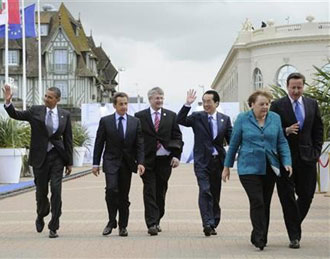The plan announced over the weekend by German Chancellor Angela Merkel to phase out nuclear power by 2022 is impressive for at least two reasons.
First, it’s very ambitious. Currently Germany gets about 25% of its electricity from nuclear power plants. Nearly 40% of that had come from the seven reactors that were shut down recently under a temporary moratorium triggered by the crisis at the Fukushima I power plant. Merkel plans to make that moratorium permanent, replacing the lost output in the near term by boosting conventionally-fired plants to full capacity while keeping the shuttered plants on “cold standby” to cope with emergency shortages. In the long term the power from those and remaining 11 reactors to be shut down by 2022 will be replaced by accelerating construction of renewable energy plants. If the goal is approved by a two-thirds majority of the German federal government, in only 11 years Germany will be getting 43% of its electricity from renewables — by far the highest level of any nation.
Germany’s advanced clean energy industry makes Merkel’s goal well within reach. As of 2011 the nation was already getting 17% of its electricity from renewables — about a 15-20 times higher ratio than the U.S., Japan and China. Part of that is made possible by the world’s most advanced wind-power industry which produces about 60% of its green energy. An increasingly important component is its state-of-the-art biomass plants that overtook hydropower in 2008 as the nation’s second most important renewable energy source. In the long term, biomass is likely to vie with wind as the nation’s leading green energy source.
The possibilities of biomass is proven out by an advanced German prototype plant that turns compost and waste into biogas. By using sophisticated enzymes and bacterial action, the plant achieves 30% more efficiency and a 60% faster fermentation rate than conventional plants running on food crops. The biogas is pumped into high-temperature fuel cells that convert it into electricity at an astounding 40 to 55 percent efficiency rate.
Another reason Merkel’s plan is impressive is that it directly contradicts her earlier position on nuclear power, laid out during the 2009 election campaign, in which she had pledged to extend the life of existing nuclear power plants a dozen years beyond their 2022 retirement date. By accepting Fukushima as both an epochal lesson for the world and by seizing the political opportunity to justify a reversal of her own position, Merkel is showing truly visionary leadership that will reward her nation with decades of benefits to its economy, security and global prestige. Her pledge is all the admirable because it takes to heart a lesson learned at the expense of another nation.
Naoto Kan’s pledge, which preceded Merkel’s by two days, to boost Japan’s renewable energy sources to 20% of the nation’s total is an even more ambitious departure from the nation’s current nuclear-dependent energy strategy.
First, it’s a direct challenge to the monolithic political and economic bloc formed by the long-ruling LDP and Japan’s giant corporations, especially the power monopolies for whom nuclear energy represents decades of uninterrupted fat profits. Kan’s pledge amounts to a frontal attack on hundreds of billions of dollars of annual profits for power companies and the corporations that make nuclear components and assemble power plants. No Japanese prime minister had ever set himself up in such naked opposition to so much economic clout. Even with a majority of Japan’s population supporting a push away from nuclear power, the counter-attack is likely to be fierce and relentless.
Secondly, Kan’s pledge represents a much bigger leap in both economic and technological terms. Compared with Germany’s, Japan’s renewable industry is a fledgling one that has been kept firmly in its infancy by concerted establishment support for nuclear power. To multiply green energy capacity 20-fold in a decade will be two orders of magnitude more difficult than Merkel’s pledge to go from 17% to 43%. Not the least of the hurdles will be the need to foster a level of technological innovation and creativity that Japan simply has never known. Even during the 1970s and 1980s as it rose to dominate the global auto and consumer electronics industries, its corporations were mostly refining production methods for scaling up existing technology. This time it will have to foster technologies that don’t yet exist, and it will have to do it quickly. Alternatively, it will have to somehow become a low-cost production base for technologies imported from Germany, India, the U.S. and China.
The pledges of Merkel and Kan has set up a kind of green-energy race between these two export powerhouses. And it will challenge the U.S., China, S. Korea and other advanced nations to redouble their green energy efforts. The ultimate winner can only be planet earth.

